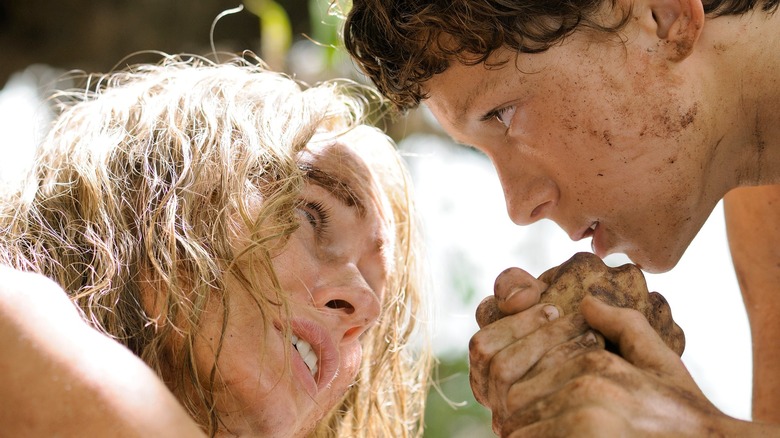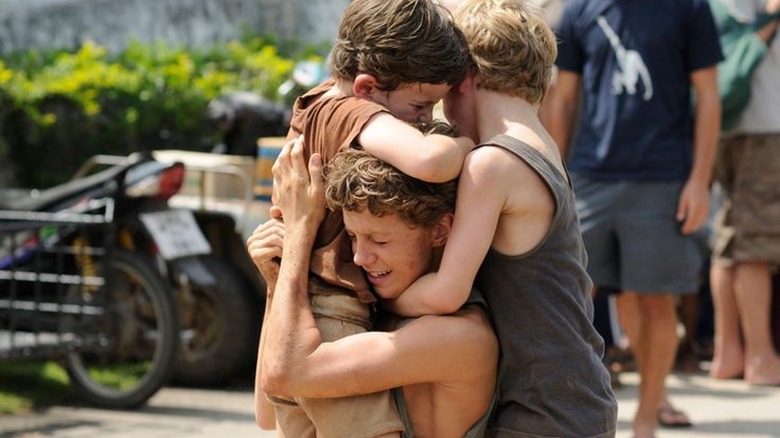A 2012 Ewan McGregor Drama Is Making A Steady Climb Up Netflix's Top Charts
In 2004, The Indian Ocean tsunami hit parts of Southeast Asia, claiming more than 227,898 lives and devastating countless families who were torn apart due to the environmental disaster. The story of María Belón, who was among several who experienced and survived the tsunami in Khao Lak, Thailand serves as the inspiration for Spanish filmmaker J. A. Bayona's disaster drama, "The Impossible." Belón herself was involved with the screenwriting process of the film to ensure the authenticity of the events, and apart from a few alterations made for dramatic effect, "The Impossible" captures the harrowing perspective of disaster survivors who often have to contend with the helpless despair of being separated from their loved ones.
Perhaps the appeal of this raw, vulnerable human sentiment is the reason why "The Impossible" has currently earned a place in the Top 10 Netflix Charts in the U.S. Released in 2012, "The Impossible" tells a story that's grounded in its treatment of the real-life disaster, compassionately depicting the aftermath of the inundation of the affected areas, along with the visceral distress that survivors undergo in a way that feels honest and emotionally-resonant.
The story begins in the luxurious, peaceful Orchid Beach Resort, where British couple Maria (Naomi Watts) and Henry (Ewan McGregor) Bennett arrive to spend their Christmas holiday with their children, Lucas (Tom Holland, in his debut role), Simon (Oaklee Pendergast), and Thomas (Samuel Joslin). The family settles into their beachside villa, carrying on with life in the mundane ways we often take for granted, and all hell breaks loose when the disaster strikes, separating Maria and Lucas from the rest amid the chaos.
The pain of separation
After Maria suffers serious injuries, she and Lucas are taken to a hospital in Takua Pa, where the former undergoes surgeries for her wounds. Having been separated from his father and sibling, a distressed Lucas helplessly waits in the hospital, having no other choice but to hope that his family is safe. The manner in which Bayona decides to shoot the tsunami sequence is rather interesting — the perspective of the sea dominates, emerging as a sentient force that consumes and engulfs countless without biases. Elsewhere, Henry survives the disaster along with his two sons, but leaves them with a local disaster relief crew to be taken to safety, so that he can stay back and search for Maria and Lucas.
The distress embedded into these scenes, coupled with the way in which the other survivors frantically look for their kin is woven with startling authenticity, where the greatest source of despair is not knowing what has befallen someone you love. While there's plenty to admire about "The Impossible," it is difficult to overlook the decision to cast white actors in roles that ideally should have been portrayed by Spanish performers to authentically reflect the experiences of the Belóns. While this does not completely detract from the film's beating heart (and Bayon's sincere intentions), it does feel bizarre considering those whose lives were actually impacted by the Indian Ocean Tsunami almost 19 years ago.
Nonetheless, "The Impossible" is not your by-the-book disaster drama that leans heavily on manufactured sentimentality to induce strong emotions or evoke empathy. There's real technical prowess in the way in which everything is pieced together to form a harrowing vignette of losing and finding one's way back to family amid unimaginable duress.
"The Impossible" is currently streaming on Netflix.

